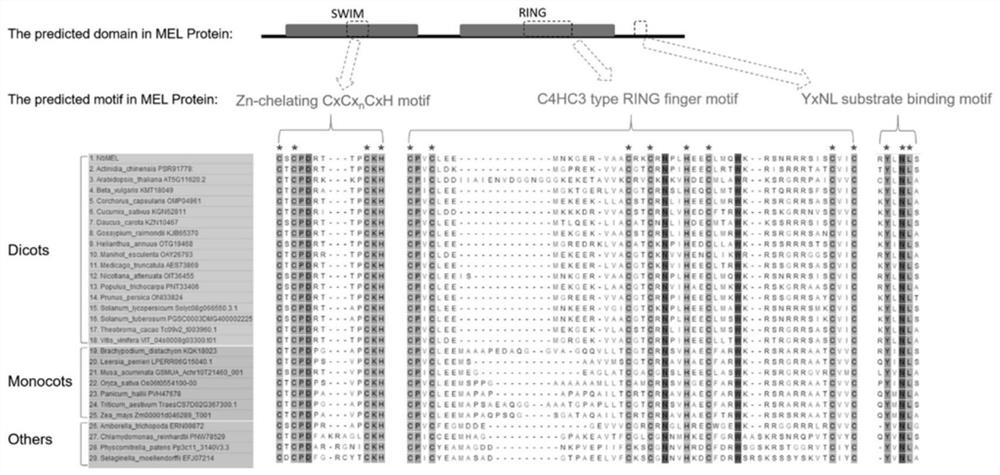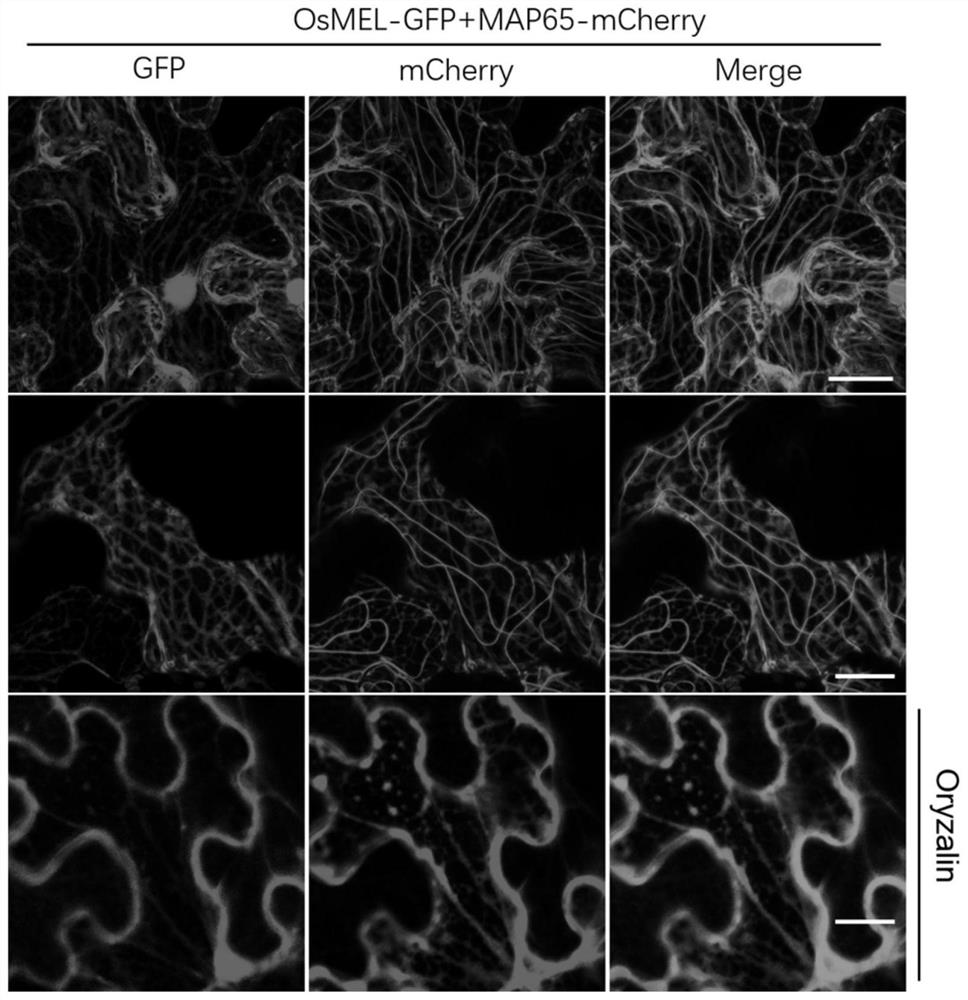Plant immunoregulation related protein and application thereof
A technology of immune regulation and related proteins, applied in the field of plant genetic engineering, can solve the problems of pesticide residues in the natural environment, agricultural production yield and quality decline, and negative impacts, and achieve the effect of improving broad-spectrum disease resistance
- Summary
- Abstract
- Description
- Claims
- Application Information
AI Technical Summary
Problems solved by technology
Method used
Image
Examples
Embodiment 1
[0043] The conservation analysis of embodiment 1 plant kingdom MEL gene
[0044] The present invention screens genes that may be involved in plant immune regulation, selects MEL homologous genes of 17 monocots, 7 dicotyledons and 4 lower plants, and compares the conservation of the MEL gene in the plant kingdom analyze. The results show that the above-mentioned plant MEL genes contain two known conserved domains, that is, the N-terminal contains a SWIM domain, and the C-terminal contains a C4HC3-type RING domain. Analysis of the sequence characteristics found that the plant MEL genes contain SWIM domains. The domain sequence is characterized as CxCx n CxH; The C4HC3 type RING domain sequence contained in the plant MEL gene is characterized by Cx 2 Cx n Cx 2 Cx 4 Hx 2 Cx n Cx 2 C; Sequence analysis found that the C-terminus of each of the above-mentioned plant MEL genes also contained a new motif, which we named as Motif, sequence features YxNL. ( figure 1 ).
[00...
Embodiment 2
[0048] Example 2 Rice MEL gene OsMEL subcellular localization
[0049] The rice MEL gene OsMEL was selected as a representative to analyze the subcellular localization of the MEL gene. The specific method is as follows. The C-terminus of OsMEL protein was fused with a GFP fluorescent tag, and the lower epidermis of Nicotiana benthamiana leaves was infiltrated by Agrobacterium, and the microtubule marker protein MAP65-mCherry was infiltrated at the same time as the microtubule marker signal. The subcellular localization of OsMEL-GFP protein was observed by confocal laser microscopy, and the results showed that OsMEL-GFP presents a filamentous localization in the cytoplasm, and the filamentous localization is co-localized with the microtubule marker protein MAP65-mCherry, indicating that OsMEL protein is localized in the cell of microtubules. At the same time, it was also observed that the cell nuclei showed a localization signal of green fluorescence, indicating that OsMEL cou...
Embodiment 3
[0050] Example 3 Verifies that MEL is an E3 ubiquitin ligase
[0051] Since MEL contains a RING domain, it may be an E3 ubiquitin ligase. In order to verify this speculation, OsMEL was constructed into a yeast two-hybrid vector to verify whether there is an interaction with E2 (UbcH5b). The specific method is to add 100mM LiAc to the yeast competent cells, incubate at 30°C for 30 minutes, centrifuge to remove the supernatant and add 350 microliters of resuspension buffer (30% PEG3350, 100mM LiAc, 250ng / mL Salmon DNA ) and 500ng interaction plasmid, after incubation at 42°C for 30 minutes, centrifuge at the highest speed to take the precipitate and apply it to the two-deficient plate (SC / -Leu-Trp), and transfer it to the third / four-deficient plate (SC / -Leu-Trp-His or SC / -Leu-Trp-His-Ade). The results showed that OsMEL and UbcH5b co-transfected yeast could grow on the three-deficient yeast plate, indicating that there was an interaction between OsMEL and UbcH5b in yeast, and t...
PUM
 Login to View More
Login to View More Abstract
Description
Claims
Application Information
 Login to View More
Login to View More - R&D
- Intellectual Property
- Life Sciences
- Materials
- Tech Scout
- Unparalleled Data Quality
- Higher Quality Content
- 60% Fewer Hallucinations
Browse by: Latest US Patents, China's latest patents, Technical Efficacy Thesaurus, Application Domain, Technology Topic, Popular Technical Reports.
© 2025 PatSnap. All rights reserved.Legal|Privacy policy|Modern Slavery Act Transparency Statement|Sitemap|About US| Contact US: help@patsnap.com



